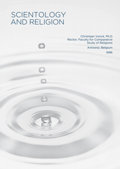What is the definition of a religion? Even recognized (not all political structures recognize religions) and traditional, established religions often question their origin in an effort to prove they are actually the only true religion. Anyone who says, “My master is the greatest incarnation of God, or the only enlightened master,” is unquestionably ignorant. The yardstick of judging fully enlightened spiritual leaders is possessed only by fully enlightened disciples. An enlightened disciple is completely loyal to his master, the teacher or guru who showed him the way of enlightenment, but he always respects other avatars and masters.1
“So many different definitions [of religion] have been framed in the West over the years that even a partial listing would be impractical,” states the Encyclopedia of Religion (Mircea Eliade, Macmillan, London/New York: 1986, p. 283). I must therefore be content with some of the characteristics of religious experience and the knowledge that religions have a deep cultural and social basis.
In the most general context, religion is man’s search for a link with the “spiritual”—actually a unification—often including or leading to worship.
For Christians this means getting back to the stage before the “fall of man,” which they believe is possible through the Son of God, Jesus Christ. In other words, religion (Jesus) unites and is a symbol for unity with God and Man. A main problem of religion, however, is that each religion’s theologians view it differently. It can be said that religion unites and theology divides. But theology is needed in order to understand religion and religions.
In his book Das Heilige, Rudolf Otto (1869–1937) defines the essence of religious awareness as awe, a unique blend of fear and fascination before the divine. Quoting many experiences, from India, Morocco and his own country, he concludes that men, all men, do from time to time acknowledge the “wholly otherness.”
Mircea Eliade (1907–86) would add that knowledge concerning God is not limited to experience. It is exemplified in symbolisms and rituals, all over the world. Symbols, rituals and experiences result in searching for why man acts the way he acts. Symbols and rituals are rooted in mythology.
With these definitions in mind, I therefore use two common statements about the main characteristics of a religion. One is mentioned by Dr. Rainer Flashe (Marburg) on page 27 in “Acta Comparanda II” (Antwerp 1987): “By a new religion we mean a religious movement centered on a new doctrine, a new cult, and a new community established through these two factors.”
The second statement or definition I take from Dr. W. Lutjeharm (Brussels) of the Hernhutter religion in a study on Zinzendorf and the numinous which proves that all religions are a product of evolution (Brusselse Theologische Studies, Number 1, 1976, p. 6): At the moment a group of people comes together due to a common experience and bow, there is religion. When they—this group—use this act as a habit we can speak about a concrete religion, Religionsanstalt. When somebody takes the lead, becomes in charge, and tells the people that they have to act in the same way, then it is a denomination or a sect. And if somebody likes to do it in another way, he can start a new sect. In that way, all the people worship the Being “das uns so einen Schauer macht.”
In a religion we can therefore expect to find a link or unification with the spiritual and the transcendental; a doctrine and praxis as well as symbols, rituals and experiences connected with this transcendental realm; and a community centered around such beliefs and praxis.




























